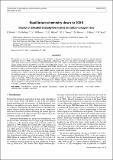Files in this item
Equlibrium chemistry down to 100 K : impact of silicates and phyllosilicates on the carbon to oxygen ratio
Item metadata
| dc.contributor.author | Woitke, Peter | |
| dc.contributor.author | Helling, Christiane | |
| dc.contributor.author | Hunter, G.H. | |
| dc.contributor.author | Millard, J.D. | |
| dc.contributor.author | Turner, G.E. | |
| dc.contributor.author | Worters, M. | |
| dc.contributor.author | Blecic, J. | |
| dc.contributor.author | Stock, J.W. | |
| dc.date.accessioned | 2017-12-04T15:30:06Z | |
| dc.date.available | 2017-12-04T15:30:06Z | |
| dc.date.issued | 2018-06 | |
| dc.identifier.citation | Woitke , P , Helling , C , Hunter , G H , Millard , J D , Turner , G E , Worters , M , Blecic , J & Stock , J W 2018 , ' Equlibrium chemistry down to 100 K : impact of silicates and phyllosilicates on the carbon to oxygen ratio ' , Astronomy & Astrophysics , vol. 614 , A1 . https://doi.org/10.1051/0004-6361/201732193 | en |
| dc.identifier.issn | 0004-6361 | |
| dc.identifier.other | PURE: 251693337 | |
| dc.identifier.other | PURE UUID: b9c215e4-4e8e-4a78-8a2e-d4ee6f0961be | |
| dc.identifier.other | Scopus: 85048857363 | |
| dc.identifier.other | WOS: 000434848200001 | |
| dc.identifier.uri | https://hdl.handle.net/10023/12245 | |
| dc.description | The research leading to these results has received funding from the European Union Seventh Framework Programme FP7-2011 under grant agreement no 284405. Jasmina Blecic is supported by NASA trough the NASA ROSES-2016/Exoplanets Research Program, grant NNX17AC03G. Christiane Helling highlights the hospitality of the Rijksuniversiteit Groningen and the Universiteit van Amsterdam with travel support from NWO and LKBF. | en |
| dc.description.abstract | We have introduced a fast and versatile computer code, GGCHEM, to determine the chemical composition of gases in thermo-chemical equilibrium down to 100 K, with or without equilibrium condensation. We have reviewed the data for molecular equilibrium constants, kp(T), from several sources and discussed which functional fits are most suitable for low temperatures. We benchmarked our results against another chemical equilibrium code. We collected Gibbs free energies, ∆G◦−f , for about 200 solid and liquid species from the NIST-JANAF database and the geophysical database SUPCRTBL. We discussed the condensation sequence of the elements with solar abundances in phase equilibrium down to 100 K. Once the major magnesium silicates Mg2SiO4[s] and MgSiO3[s] have formed, the dust to gas mass ratio jumps to a value of about 0.0045 which is significantly lower than the often assumed value of 0.01. Silicate condensation is found to increase the carbon to oxygen ratio (C/O) in the gas from its solar value of ∼ 0.55 up to ∼ 0.71, and, by the additional intake of water and hydroxyl into the solid matrix, the formation of phyllosilicates at temperatures below ∼ 400 K increases the gaseous C/O further to about 0.83. Metallic tungsten (W) is the first condensate found to become thermodynamically stable around 1600 − 2200 K (depending on pressure), several hundreds of Kelvin before subsequent materials such as zirconium dioxide (ZrO2) or corundum (Al2O3) can condense. We briefly discuss whether tungsten, despite its low abundance of ∼ 2 × 10−7 times the silicon abundance, could provide the first seed particles for astrophysical dust formation. | |
| dc.format.extent | 28 | |
| dc.language.iso | eng | |
| dc.relation.ispartof | Astronomy & Astrophysics | en |
| dc.rights | © 2018, ESO. This work has been made available online in accordance with the publisher’s policies. This is the author created, accepted version manuscript following peer review and may differ slightly from the final published version. The final published version of this work is available at https://doi.org/10.1051/0004-6361/201732193 | en |
| dc.subject | Astrochemistry | en |
| dc.subject | Planets and satellites: atmospheres | en |
| dc.subject | Planets and satellites: composition | en |
| dc.subject | Stars: winds, outflows | en |
| dc.subject | Molecular data | en |
| dc.subject | Methods: numerical | en |
| dc.subject | QB Astronomy | en |
| dc.subject | QC Physics | en |
| dc.subject | DAS | en |
| dc.subject | BDC | en |
| dc.subject.lcc | QB | en |
| dc.subject.lcc | QC | en |
| dc.title | Equlibrium chemistry down to 100 K : impact of silicates and phyllosilicates on the carbon to oxygen ratio | en |
| dc.type | Journal article | en |
| dc.contributor.sponsor | European Commission | en |
| dc.description.version | Postprint | en |
| dc.contributor.institution | University of St Andrews. School of Physics and Astronomy | en |
| dc.contributor.institution | University of St Andrews. St Andrews Centre for Exoplanet Science | en |
| dc.identifier.doi | https://doi.org/10.1051/0004-6361/201732193 | |
| dc.description.status | Peer reviewed | en |
| dc.identifier.grantnumber | 284405 | en |
This item appears in the following Collection(s)
Items in the St Andrews Research Repository are protected by copyright, with all rights reserved, unless otherwise indicated.

